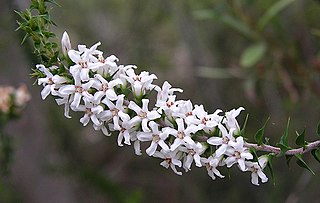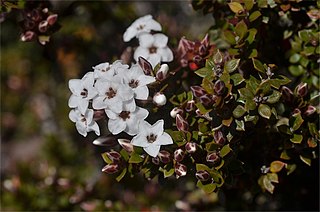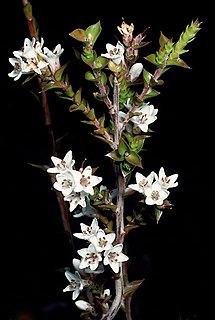
Epacris pulchella, commonly known as wallum heath or coral heath is a species of flowering plant in the family Ericaceae and is endemic to eastern Australia. It is a slender, erect shrub with egg-shaped, pointed leaves and white or pinkish, tube-shaped flowers.

Epacris serpyllifoliais a species of flowering plant in the heath family Ericaceae and is endemic to Tasmania. It is a small low-lying or weakly erect shrub with heart-shaped to broadly egg-shaped leaves and tube-shaped white flowers crowded in upper leaf axils.

Epacris lanuginosa, commonly known as woolly-style heath, is a species of flowering plant in the family Ericaceae and is endemic to south-eastern Australia. It is a slender, erect shrub with hairy branchlets, linear to lance-shaped leaves, and tube-shaped, white flowers crowded along the ends of the branches.

Epacris browniae is a species of flowering plant in the heath family Ericaceae and is endemic to a small area of New South Wales. It is an erect, woody shrub with wand-like branchlets, crowded, glabrous, trowel-shaped leaves and tube-shaped flowers with white petals.

Epacris gnidioides, commonly known as Budawangs cliff-heath, is a species of flowering plant in the heath family Ericaceae and is endemic to a restricted area of New South Wales. It is a small, creeping shrub with hairy branches, sharply-pointed lance-shaped leaves, and tube-shaped, white flowers.

Epacris crassifolia is a species of flowering plant in the heath family Ericaceae and is endemic to south-eastern New South Wales, Australia. It is a low-lying shrub with elliptic to egg-shaped leaves with the lower end towards the base, and tube-shaped, white or cream-coloured flowers clustered near the ends of the branches.
Epacris apsleyensis is a species of flowering plant in the heath family Ericaceae and is endemic to a small area of Tasmania. It is an erect shrub with hairy branchlets, lance-shaped to elliptic leaves and tube-shaped flowers with white petals.

Epacris curtisiae is a species of flowering plant in the heath family Ericaceae and is endemic to north-western Tasmania. It is a shrub with egg-shaped to almost circular leaves and tube-shaped white flowers crowded in upper leaf axils.
Epacris exserta , commonly known as South Esk heath, is a species of flowering plant in the heath family, Ericaceae and is endemic to Tasmania. It is an erect shrub with narrowly lance-shaped to elliptic leaves and tube-shaped, white flowers clustered near the ends of the branches.

Epacris glabella, commonly known as smooth heath, is a species of flowering plant in the heath family, Ericaceae, and is endemic to Tasmania. It is a shrub with erect branches, egg-shaped to elliptic leaves and white, tube-shaped flowers.
Epacris grandis, commonly known as grand heath or tall heath, is a species of flowering plant in the heath family Ericaceae and is endemic to a small area of Tasmania. It is a robust, erect shrub with smooth stems, lance-shaped leaves and tube-shaped flowers with white petals.

Epacris graniticola, commonly known as granite heath, is a species of flowering plant in the heath family Ericaceae and is endemic to Tasmania. It is an erect shrub with egg-shaped leaves and tube-shaped white flowers mostly clustered near the ends of branches.
Epacris limbata, commonly known as bordered heath or border heath, is a species of flowering plant in the heath family Ericaceae and is endemic to a restricted area of Tasmania. It is an erect shrub with narrowly heart-shaped or broadly egg-shaped, stem-clasping, sharply-pointed leaves and tube-shaped white flowers clustered along the ends of branches.

Epacris marginata is a species of flowering plant in the heath family Ericaceae and is endemic to Tasmania. It is an erect shrub with overlapping, bluish, sharply-pointed, egg-shaped to lance-shaped leaves with transparent edges, and white, tube-shaped flowers, the petals with lobes 3–5 mm (0.12–0.20 in) long and 2.5–3.0 mm (0.098–0.118 in) wide.
Epacris moscaliana, commonly known as seepage heath, is a species of flowering plant in the heath family Ericaceae and is endemic to Tasmania. It is a bushy shrub with wand-like branches, narrowly lance-shaped to egg-shaped or round leaves, and bell-shaped white flowers in clusters at the ends of the branches.

Epacris acuminata , commonly known as claspleaf heath, is a species of flowering plant in the heath family Ericaceae and is endemic to Tasmania. It is a small, spreading shrub with egg-shaped, stem-clasping leaves and tube-shaped flowers with white petals.

Epacris mucronulata is a species of flowering plant in the heath family Ericaceae and is endemic to Tasmania. It is an erect shrub with softly-hairy young branches, lance-shaped leaves, and cylindrical white flowers in small groups at the ends of the branches.

Epacris myrtifolia is a species of flowering plant in the heath family Ericaceae and is endemic to Tasmania. It is an erect shrub that typically grows to a height of 15–50 cm (5.9–19.7 in). Its leaves are thick, crowded, egg-shaped with a small, blunt point on the tip, and 4.2–8.5 mm (0.17–0.33 in) long. The flowers are arranged singly in a few upper leaf axils with many leathery bracts at the base. The sepals are leathery, about 4.2 mm (0.17 in) long, the petal tube slightly shorter than the sepals with lobes about the same length, the anthers protruding slightly from the petal tube.

Epacris purpurascens is a species of flowering plant in the heath family Ericaceae and is endemic to eastern New South Wales. It is an erect shrub with egg-shaped or heart-shaped, sharply-pointed leaves and white or pink, tube-shaped flowers.

Epacris tasmanica is a species of flowering plant in the heath family Ericaceae and is endemic to Tasmania. It is an erect shrub with lance-shaped leaves and tube-shaped white flowers crowded in upper leaf axils.

















